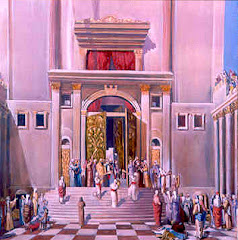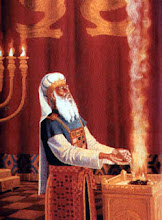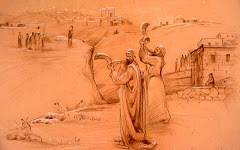 Ultimamente y por distintas razones me he vuelto a hacer la misma pregunta que muchas veces me hice, Vale la pena?? O mejor dicho ¡Para que ser un judio Observante hoy en dia, en un mundo tan "moderno" que busca constantemente el adquirir y parecer, el materialismo como ley y si a ello le sumamos los "riesgos" concretos (atentados, persecuciones, agresiones, etc) de ser visiblemente judio (usar kipa, no trabajar en Shabat, ir a una marcha por Israel, etc) entonces esta pregunta nos puede parecer fuertemente válida.
Ultimamente y por distintas razones me he vuelto a hacer la misma pregunta que muchas veces me hice, Vale la pena?? O mejor dicho ¡Para que ser un judio Observante hoy en dia, en un mundo tan "moderno" que busca constantemente el adquirir y parecer, el materialismo como ley y si a ello le sumamos los "riesgos" concretos (atentados, persecuciones, agresiones, etc) de ser visiblemente judio (usar kipa, no trabajar en Shabat, ir a una marcha por Israel, etc) entonces esta pregunta nos puede parecer fuertemente válida. Creo que el punto esencial de esta pregunta radica en el ¿PARA QUE?, cual es la finalidad?,
Creo que el punto esencial de esta pregunta radica en el ¿PARA QUE?, cual es la finalidad?,Y Cuando pienso en "Tarea Dificíl" pienso mas que nada en las repercusiones abstractas de nuestras acciones, es decir pocas veces vemos los resultados de nuestras acciones positivas en forma directa. Pero más aun, lo que veamos por más perceptivos que seamos, siempre sera una ínfima parte de la realidad, del todo. Y la matemática nos ayuda en esto y nos dice algo que me fascina y me hace necesariamente más humilde y es que 1/oo= o, mejor dicho uno dividido infinito es igual a cero...
Y a eso apunto...si la finalidad o el Para que de la Creación por parte de D-s, es "crear una morada en los planos inferiores" Midrash (Tanjuma, Naso 16) y ello se logra por medio de la elevacion de la materia a un plano espiritual, "El refinamiento de las chispas" (Birur Nitzotzot en términos místicos), Si esa es la finalidad entonces me pregunto ¿Como puede ser que debamos vivir tan a ciegas en un tan corto periodo de tiempo, en nuestro paso por este plano de existencia? Realmente ello es algo que me molesta..ahora bien..
Observemos la Creación y nos daremos cuenta de que podría parecernos increíble que el hombre sea el objetivo, el pináculo de todo, casi diria egocéntrico, las estrellas por ejemplo al igual que el hombre nacen, crecen y mueren ¡Pero tardan millones y miles de millones de años en ese proceso! y si miramos la cantidad nos maravillamos, solo en nuestra galaxia cuenta con un diámetro medio de unos 100.000 años luz, se calcula que contiene entre 200 y 400 mil millones de estrellas, y a su vez se estima que existen más de cien mil millones de galaxias en el universo observable.
Pero a pesar de semejante magnitud, pensemos que se estima que casi tres cuartas partes de la masa-energía total del universo es energía oscura y si de hecho el universo se esta expandiendo, todo lo conocido terminara en una noche muy larga. En relación a ello la ciencia nos da la posibilidad de que existan muchos universos paralelos (véase la teoría de las supercuerdas, teoría M), etc.
 Entonces me vuelvo a hacer la pregunta.. ¿ Vale la Pena tanto esfuerzo siendo tan aparentemente insignificante, tan fugaces y frágiles y aún así tener la osadía de decir acá estoy??
Entonces me vuelvo a hacer la pregunta.. ¿ Vale la Pena tanto esfuerzo siendo tan aparentemente insignificante, tan fugaces y frágiles y aún así tener la osadía de decir acá estoy??
La Respuesta es sin dudas que SI y la clave de la creación sin dudas está en el hombre, ya que en definitiva es el hombre y mas enfáticamente el judio el hace de puente o punto de conexión entre "el cielo y la tierra" el que desciende uno y eleva el otro para fusionarse en una realidad concreta.
Y ello me parece más fascinante aún que el vasto cosmos o el microcosmos a nivel cuántico aunque siendo sincero mantengo firmemente la opinión de que ser sensible a ese conocimiento nos ayuda a ver mas allá de la "Matrix", de la máscara del mundo y eleva nuestro nivel de conciencia a una unicidad y sobre todo a lo que hay en juego, si bien una vez más es solo una ínfima proporción del entendimiento del infinito...
Acerca Del Tiempo
Acerca del tiempo, que parece tan poco, nos elude y es tan efímero pero sobre todo parecería tan poco en función de lo que se nos exige..
Sobre ello me vienen a la mente dos respuestas, una me la dio mi padre y la otra mi hermano,
La primera, es que simplemente el tiempo es relativo E=mc2, entonces que es poco o mucho?? estaría en función directamente proporcional a la información que invertimos en el (el tiempo), de hecho a medida que mas rápido se mueve un objeto en relación a otro más lento pasa el tiempo...o dicho en otras palabras cuanto más hagamos, más habremos vivido...
La segunda respuesta es que ¿no es acaso mejor que este plano existencial pase tan efímeramente para luego pasar a otro verdaderamente "estable" (llámese Gan eden, Olam haba, etc).
Lo que sabemos con certeza es lo que nos dice la El Primer Principio de la Termodinámica que afirma que la cantidad total de Energía en cualquier sistema aislado (sin interacción con ningún otro sistema) permanece invariable con el tiempo, aunque dicha energía puede transformarse en otra forma de energía. En resumen, la ley de la conservación de la energía afirma que la energía no puede crearse ni destruirse, sólo se puede cambiar de una forma a otra...
Lo que la Mística Judía nos brinda en este sentido es el definir concretamente, con nombres propios esos estados.

Conclusión
Como Conclusión final me gustaría pensar que de una manera u otra..Siendo la Piedra angular de la creación (toda la creación, vease ABIA, diferentes mundos) o siendo nada al mismo tiempo, Viviendo de una manera que nuestras acciones hagan eco en la eternidad o vivir en forma simple como un punto perdido en el universo de alguna dimensión del mundo de Asia (mundo tridimensional)..
Vale la Pena toda esta gran puesta en escena y la monumental tarea asignada al judio en particular y al mundo en general.
Ionatan Hakohen, shalom.6.26 (El-Blog-del-shalom)




















